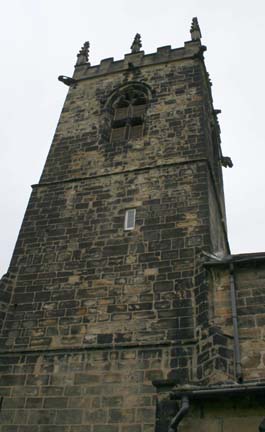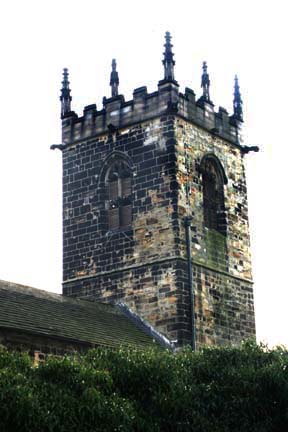Part 6
Following
the civil war and under the patronage of the Moncktons who now owned
Hodroyd Hall and lived there, plans were drawn up to increase the height
of the tower and incorporate bells in the newly built section. It isn’t
known exactly when this work began but I would like to think that it was
towards the end of the life of Michael Lambe who had served the parish as
vicar for 53 years. He would have been a very happy man as he saw the
culmination of his lifetimes work come to fruition. If one looks up at the
section of the tower that contains the ringing chamber and bell chamber
from the west unequal stonework can be clearly seen where the final
section was built on. At each corner a gargoyle, a mythical beast, was
added and from the mouth of each carving rainwater was carried away from
the roof to the detriment of the unwary beneath. It must have looked an
imposing building with its tower soaring heavenwards (see
photographs) and I imagine that the parishioners were justly proud
of it especially when the first four bells were rung for the first time.

Unlike the patronage of the Monckton family two or three untitled but
wealthy patrons in the parish St Peter’s church went from strength to
strength and soon needed better seating arrangements. For many years the
congregations of churches stood during worship except for the elderly or
the sick who had the use of stone benches round the inside walls. Hence
the origin of the well known and often used phrase, ‘The weakest to the
wall’. Seating arrangements were introduced into churches in the form of
‘box’ pews complete with doors, which separated families for reasons
unknown. Consequently the pulpit from which the priest delivered his
sermon had to be raised, sometimes with two extra decks, in order that the
holy message could be delivered to everyone. There were two decks only at
Felkirk.
As was the custom throughout every county the high-ranking families were
given priority seating and viewing arrangements.
Lord Moncktons family had their own area in the northeast corner of the
nave and elevated above the congregation, their entrance door was cut into
the north wall and the shape can still be seen. Just inside the main
entrance one can see the front of the elevated area as it looked with its
coloured marquetry 250 years ago. Extending under the organ and choir
stalls is the Monckton family vault where 16 members of their family were
interred during the period 1722 to 1810.
door was cut into
the north wall and the shape can still be seen. Just inside the main
entrance one can see the front of the elevated area as it looked with its
coloured marquetry 250 years ago. Extending under the organ and choir
stalls is the Monckton family vault where 16 members of their family were
interred during the period 1722 to 1810.
Further galleries were added during the 18th century and these
covered the north and south sides of the naïve aisles and were connected
across the west end. Access was gained by stairs on the north and south
sides. A form of heating was introduced during this period, which
consisted of a coal-fired stove in the centre of the chancel 18 feet from
the east wall. This is clearly seen on the interior plan drawn up before
work began on the restoration of 1875, Directly behind the gallery seats
which connected the north and south gallery seats was a platform on which
stood an organ, directly above where the fonts stands today. The present
day vestry was the sacristy and directly opposite the sacristy and south
of the altar was the main vestry; the step down into it can still be seen.
The pulpit was exactly opposite to where it is today and where the choir
stalls stand at present were seats that faced eastwards just as the
congregation seats face today.
Looking at the plans that were drawn up in 1875 it would
appear that the box pews had long since disappeared except for two which
stood on the north side of the centre aisle about halfway down the present
central aisle. The plans of 1875 were the last main alterations to be
carried out on St Peter’s.